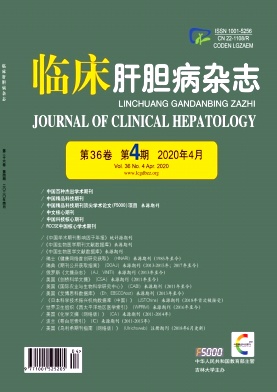|
[1] WOO PC,LAU SK,TENG JL,et al. Then and now:Use of16S r DNA gene sequencing for bacterial identification and discovery of novel bacteria in clinical microbiology laboratories[J]. Clin Microbiol Infect,2008,14(10):908-934.
|
|
[2] NOBRE SR,CABRAL JE,GOMES JJ,et al. In-hospital mortality in spontaneous bacterial peritonitis:A new predictive model[J].Eur J Gastroenterol Hepatol,2008,20(12):1176-1181.
|
|
[3] ENGELMANN C,KROHN S,PRYWEREK D,et al. Detection of molecular bacterascites in decompensated cirrhosis defines a risk with decreased survival[J]. Eur J Gastroenterol Hepatol,2016,28(11):1285-1292.
|
|
[4] HARDICK J,WON H,JENG K,et al. Identification of bacterial pathogens in ascitic fluids from patients with suspected spontaneous bacterial peritonitis by use of broad-range PCR(16S PCR)coupled with high-resolution melt analysis[J]. J Clin Microbiol,2012,50(7):2428-2432.
|
|
[5] LUTZ P,NISCHALKE HD,STRASSBURG CP,et al. Spontaneous bacterial peritonitis:The clinical challenge of a leaky gut and a cirrhotic liver[J]. World J Hepatol,2015,7(3):304-314.
|
|
[6] MINEMURA M,SHIMIZU Y. Gut microbiota and liver diseases[J]. World J Gastroenterol,2015,21(6):1691-1702.
|
|
[7] MARCHESI JR,ADAMS DH,FAVA F,et al. The gut microbiota and host health:A new clinical frontier[J]. Gut,2016,65(2):330-339.
|
|
[8] GOEL A,GUPTA M,AGGARWAL R. Gut microbiota and liver disease[J]. J Gastroenterol Hepatol,2014,29(6):1139-1148.
|
|
[9] RUNYON BA,AASLD Practice Guidelines Committee. Management of adult patients with ascites due to cirrhosis:An update[J]. Hepatology,2009,49(6):2087-2107.
|
|
[10] DUBOURG G,RAOULT D. Emerging methodologies for pathogen identification in positive blood culture testing[J]. Expert Rev Mol Diagn,2016,16(1):97-111.
|
|
[11] KROHN S,BHM S,ENGELMANN C,et al. Application of qualitative and quantitative real-time PCR,direct sequencing,and terminal restriction fragment length polymorphism analysis for detection and identification of polymicrobial 16S rRNA genes in ascites[J]. J Clin Microbiol,2014,52(5):1754-1757.
|
|
[12] FENG Y,CHEN CL,CHEN TH,et al. Application of nextgeneration sequencing to study ascitic microbiome in cirrhotic patients with or without spontaneous bacterial peritonitis[J]. J Microbiol Immunol Infect,2015,48(5):504-509.
|
|
[13] ENGELMANN C,KROHN S,PRYWEREK D,et al. Detection of molecular bacterascites in decompensated cirrhosis defines a risk with decreased survival[J]. Eur J Gastroenterol Hepatol,2016,28(11):1285-1292.
|
|
[14] FAGAN KJ,ROGERS GB,MELINO M,et al. Ascites bacterial burden and immune cell profile are associated with poor clinical outcomes in the absence of overt infection[J]. PLo S One,2015,10(3):e0120642.
|
|
[15] ROGERS GB,van der GAST CJ,BRUCE KD,et al. Ascitic microbiota composition is correlated with clinical severity in cirrhosis with portal hypertension[J]. PLo S One,2013,8(9):e74884.
|
|
[16] LUTZ P,PARCINA M,BEKEREDJIAN-DING I,et al. Spontaneous bacterial peritonitis by Pasteurella multocida under treatment with rifaximin[J]. Infection,2014,42(1):175-177.
|
|
[17] SORIANO G,ESPARCIA O,MONTEMAYOR M,et al. Bacterial DNA in the diagnosis of spontaneous bacterial peritonitis[J]. Aliment Pharmacol Ther,2011,33(2):275-284.
|
|
[18] SANTIAGO A,POZUELO M,POCA M,et al. Alteration of the serum microbiome composition in cirrhotic patients with ascites[J]. Sci Rep,2016,6:25001.
|
|
[19] CARO E,FRANCS R,ZAPATER P,et al. Grade of soluble inflammatory response is mainly affected by circulating bacterial DNA concentrations in cirrhosis[J]. Liver Int,2016,36(10):1473-1480.
|
|
[20] SCHNABL B,BRENNER DA. Interactions between the intestinal microbiome and liver diseases[J]. Gastroenterology,2014,146(6):1513-1524.
|
|
[21] OLSZAK T,NEVES JF,DOWDS CM,et al. Protective mucosal immunity mediated by epithelial CD1d and IL-10[J]. Nature,2014,509(7501):497-502.
|
|
[22] BIAGI E,CANDELA M,FAIRWEATHER-TAIT S,et al. Aging of the human metaorganism:The microbial counterpart[J].Age(Dordr),2012,34(1):247-267.
|
|
[23] ZEISSIG S,BLUMBERG RS. Commensal microbial regulation of natural killer T cells at the frontiers of the mucosal immune system[J]. FEBS Lett,2014,588(22):4188-4194.
|
|
[24] IVANOV II,HONDA K. Intestinal commensal microbes as immune modulators[J]. Cel Host Microbe,2012,12(4):496-508.
|
|
[25] CHEN Y,YANG F,LU H,et al. Characteristics of fecal microbial community in patients with cirrhosis[J]. Hepatology,2011,54(2):562-572.
|
|
[26] QIN N,LI A,FANG F,et al. Alterations of the human gut microbiome in liver cirrhosis[J]. Nature,2014,513(7516):59-64.
|
|
[27] WEI X,YAN X,ZOU D,et al. Abnormal fecal microbiota community and functions in patients with hepatitis B liver cirrhosis as revealed by a metagenomic approach[J]. BMC Gastroenterol,2013,13:175.
|
|
[28] BAJAJ JS,BETRAPALLY NS,GILLEVET PM. Decompensated cirrhosis and microbiome interpretation[J]. Nature,2015,525(7569):e1-e2.
|
|
[29] WOODHOUSE CA,PATEL VC,SINGANAGANM A,et al. The gut microbiome as a therapeutic target in the pathogenesis and treatment of chronic liver disease[J]. Aliment pharmacol Ther,2018,47(2):192-202.
|
|
[30] GRUMAZ S,STEVENS P,GRUMAZ C,et al. Next-generation sequencing diagnostics of bacteremia in septic patients[J]. Genome Med,2016,8(1):73.
|
|
[31] MARSTON DA,MCELHINNEY LM,ELLIS RJ,et al. Next generation sequencing of viral RNA genomes[J]. BMC Genomics,2013,14:444.
|
|
[32] LONG Y,ZHANG Y,GONG Y,et al. Diagnosis of sepsis with cell-free DNA by next-generation sequencing technology in ICU patients[J]. Arch Med Res,2016,47(5):365-371.
|
|
[33] MURTAZA M,DAWSON SJ,POGREBNIAK K,et al. Multifocal clonal evolution characterized using circulating tumour DNA in a case of metastatic breast cancer[J]. Nat Commun,2015,6:8760.
|
|
[34] ROGERS GB,CUTHBERTSON L,HOFFMAN LR,et al. Reducing bias in bacterial community analysis of lower respiratory infections[J]. ISME J,2013,7(4):697-706.
|
|
[35] GOODWIN S,MCPHERSON JD,MCCOMBIE WR. Coming of age:Ten years of next-generation sequencing technologies[J]. Nat Rev Genet,2016,17(6):333-351.
|







 DownLoad:
DownLoad: